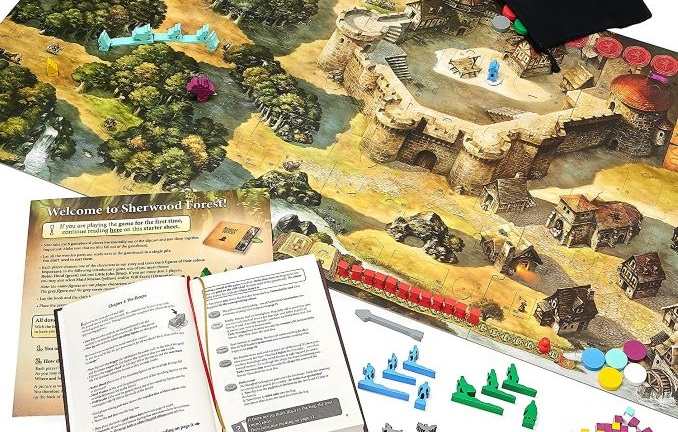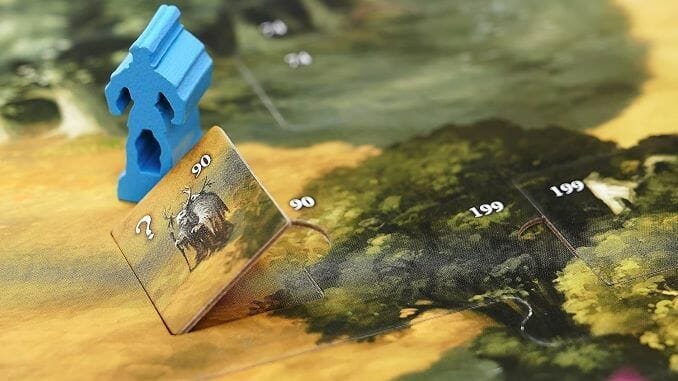Designer Michael Menzel won the Kennerspiel des Jahres (Experts’ Game of the Year) back in 2013 for his cooperative game Legends of Andor, where players worked together through a series of scenarios to defend Andor against invaders, with a narrative that unfolds over the course of multiple plays. Menzel has finally returned with his second game, The Adventures of Robin Hood, another story-based game, this time with simpler mechanics and more scenarios, while making use of a very clever system on its board to track and change encounters for the players.
Playing as Robin Hood and up to three of his band—Little John, Maid Marian, or Will Scarlett—the players work together to achieve a different objective in each scenario, with the first one serving as a tutorial for how to play the game. The Adventures of Robin Hood comes with a huge board that has several dozen tiles you will remove and flip when the game tells you to do so, often to mark that you’ve already done whatever was on that tile, whether it’s speaking to someone or examining the area for a clue. The story itself comes in a 200-page book that includes all nine of the game’s scenarios, with pages that include specific text and options for each tile you can visit in each session.
Every time one of your characters reaches one of those tiles, you turn to the page in the book matching the number on the tile, then read the text there for that specific scenario. Some of these will give you an A or B choice, and others may require that a specific character be the one to visit the tile. Since you might only be using two of the four characters—only Robin Hood is required to play after the tutorial, where you use him and Little John—each scenario offers several ways to solve its particular puzzle.
The game also has a novel system of movement that dictates how far you can move on a turn. Each player gets five tokens showing their character, two standing tokens, two short movement tokens, and one long movement token. You line up your movement tokens end to end on each turn to see how far you may move, finishing with your second standing token; as long as that is touching a tile with a question mark or a figure on it, you can examine that tile or engage in that encounter. If you choose not to use your long movement token on a turn, you can add one white ‘strength’ cube to the bag to improve your odds in future combat.

All of the game’s tokens go into a common bag, which includes the large turn order tokens, the cardboard seals used to randomize the appearance of guards and noblemen on the board, and the small cubes used to determine combat. You start each scenario with more violet cubes, representing the villains, than white cubes for our heroes, and may add to both over the course of the session. The board has regions that are shaded, where players are safe from guards, and regions in sunlight, where players may be ‘captured’ by guards. A captured player must fight the guard on their next turn by drawing three cubes from the bag; if they draw a single white cube, they win the combat, and are free to move on their next turn. The same applies when a player robs a nobleman, which brings less risk and bigger rewards to the players.
There is a time limit on each scenario determined by a set number of hourglass tokens placed on the board to start the session, which drops by one in every round when the villains’ red turn token is drawn from the bag. There’s also a “hope” tracker that can accelerate the pace if it reaches zero, after which you remove two tokens instead of one, although you can increase hope by winning fights against guards or successfully robbing the noblemen.
The mechanics are very simple here and the game’s promise that you’ll be playing your first scenario within five minutes holds true—you put together the board, place your tokens, and then follow the text in the first dozen or so pages of the book. It walks you through the first scenario, explaining movement, combat, and how to use the board. Each scenario has a unique setup that’s clearly explained at the start of its section, where you’ll flip certain tiles on the board and fill the bag with a specific combination of cubes. The scenarios are well calibrated to be winnable for even new players, so they might be too easy for serious gamers, although they’re still fun to play through because the nature of the challenges requires some deduction and close examination of the board.
The Adventures of Robin Hood sits in the space between legacy games, where the board and pieces change from play to play, and a second playthrough is impossible; and traditional games, where each play is independent from the previous session. There’s a narrative throughline here, with each session assuming you’ve played the previous one so you follow the story, but you can go back at any point to replay a previous scenario, whether to try with new people at the table or to use different characters. It’s also light enough for family play, as long as one person is comfortable as the narrator, since there’s a lot of text involved. Menzel seems to have a real niche going here, and I hope it’s not another eight years before his next game.
Keith Law is the author of The Inside Game and Smart Baseball and a senior baseball writer for The Athletic. You can find his personal blog the dish, covering games, literature, and more, at meadowparty.com/blog.

